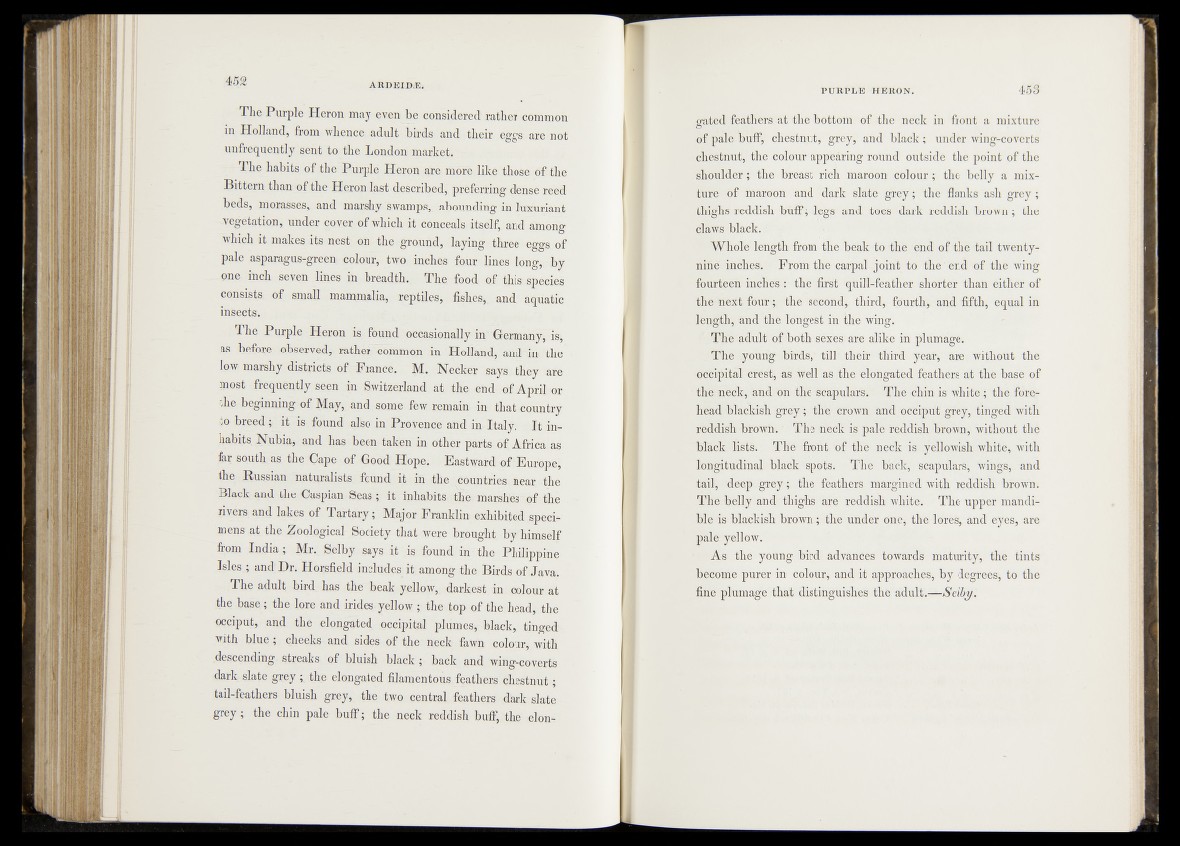
The Purple Heron may even be considered rather common
in Holland, from whence- adult birds and their eggs, are'not
unfrequently sent to the London m a r k e d
-T^he habiti; ofrthe Purple Heron are more.like,Jthoaevdfrthe.
Bittern than of the Heron last described;. preferring dense reed
.beds, morasses, and marshy swamps,, abounding in luxuriant
-vegetation, under cover b f which it cbncea^; itself,.tfnd among
which it makes its-nest on the-ground, laying three eggs., of
pale asparagus-green .colour, two inches four lines d ^gy-by
-o n e inch seven lines in breadth., The,-food of .t^MecdeS
consists., of small mammalia, reptiles, fishes*,, and. aquatic
insects. ,
The Purple Heron is found occasionally in "Germany, is,
as before observed, rather common in Holland, and“ini|.the"
low marshy districts of'France. ~ M. Necker j-say^they are
most frequently seen in Switzerland a t #b*i©nd o f^ p r ilo r
the- beginning of May, and some- few remain in > that-country
to breed; it is found also in Provence’and in Italy.1 It inhabits.
Nnbia, and has been- taken in; other parts of, Africans
far south as the Gape of Good Hope. Eastward of r-tEurop.ej
the Russian naturalists, found it in the,Mtountries, nean--the
Black; and the Caspian Seas ; ftrinhabits, the. marsh&rof the
rivers; and lakes of Tartary ; Major Franklin.-e/alaihifed speci-
mens at, the Zoological Society that were brought b y rhimself
from India; Mr. Selby says it ,is found in the Philippine
Isles,; and; Dr. Horsfield includes-it; among the BirdsM Java;
The adult, bird, has the beak yellow,, darkest., in colour at
the base; the lore and irides: yellow ;. the top of the, head, the
occiput, and the elongated occipital plumes*- black, tinged
with blue; cheeks and sides of the neck- fawn colour, with
descending streaks of bluish black; back and wing-coverts
dark slate grey ;. the elongated filamentous,, feathers chestnut;
tail-feathers bluish grey, the two central feathers dark slate
grey; the chin pale buff; the neck reddish buff, the elon4
gatedf feathers’’at dhe bottom of the neck in front a mixture
Of pale- buff, obê'ét-nut, ''gre^y, and black; under wing-coverts
'Ch'èsthuf^-tKê eo'lè-ur applÉring round outside the point of the
shoulder; the'-breast-'rich maroon colour ; the belly a mixture
^ fr^ ^ i^É ^ a d d dark slate grey; the flanks ash grey;
and tóés dark reddish brown; the
clfe'ks black.
'’Wbolêvlèngih' from ipe beak to the *end of the tail twenty-
nifie - ifrclSiw From the- carpal the end of the wing
fbwteeh inchest the first-qéil'1-fealbei shorter than either of
tmbmèxt four the MiflMd, !third, fourth, and fifth, equal in
leqgtljy-and thé 1'drPgést in the wing. :
^.The adul-t f tn$fek'es. are alike in plumage;
The birds,' tillytheir third year*. are without the
^ceipital crest* as welfas jtrhe'elobJ^Éd|feathers at the base of
th'ë^iÓkylah d oh-the ‘scapular^; Thi^fftóii is white; the forehead
fiackash thy rCrdwn and Ipfipu'b grey* tinged with
reddish-brown. ‘ Thë'medlds pale’reddish brown, without thé
blackpkCtlt. The-fr ónt b f the1 u e tk fis yellowish white, with
tehg it^in g i'b la<m ^ d& The back, scapular^; "wings, and
tai(h,' ^ b ^ g re y -; the feathefk: margined with reddish brown.
The bel-ly-and thighabre reddish White.- The U|ipef raahdi-
bl#isdSackish brown; the finder ofigj the lores, and éyes, are
pale yellow.
||i É : the yohngipird advances towards maturity, the tints
become purer in colour, and it approaches, by degrees, to the
fine plumage'that distinguishes the adult.-M?e$y.*